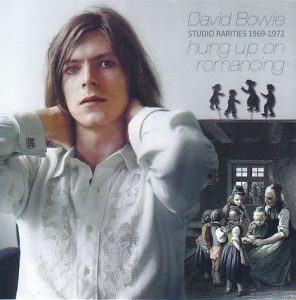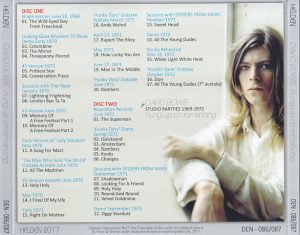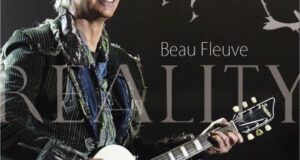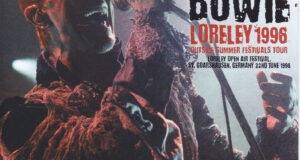David Bowie / Hung Up On Romancing / 2CD / Helden
Translated Text:
Studio Rarities 1969-1972. Digitally Remastered
Click Image To Enlarge
Although it is possible to divide the time of the Bowie into several, it is possible to argue that it is roughly “initial” from “Space Oddity” to the Ziggy era, following the first period. This work will be the title which recorded the initial studio out take and another version. Speaking of the album, the four albums “Space Oddity”, “The Man Who Sold The World”, “Hunky Dory” and “Ziggy Stardust” overlap at the time of release. Both are different from what you can listen now, which is very interesting content.
【DISC ONE】
01. The Wild Eyed Boy From Freecloud
It is a single version released on June 20, 1969 of the same song recorded on the album “Space Oddity”. Beginning with the cutting of Akogi, the Bowie’s vocals are in front of the mix. Although string instruments are contained, the main is a talking style of Bowie’s acoustic to the last. I would like you to compare it with an exotic original version.
02. Columbine
03. The Mirror
04. Threepenny Pierrot
It is a demonstration sound source for TV show “Looking Glass Murders” that appeared in early 1970. It is not unusual for the performers themselves to appear, but for demonstrations as demonstrations. Two songs are recorded by playing by Bowie’s acoustic style. Both are quiet songs that were influenced by Dylan. Changing voice tone and using Hamming, Bowie himself is a sound source as if he is still searching for his own style. Only the last “Threepenny Pierrot” is a playful song by a light piano. The melody is obviously “London Bye Ta-Ta” of the later year, the lyrics are also significantly different, and the song composition is incomplete, but there is no doubt that it is the original song of this song.
05. Prettiest Star
06. Conversation Piece
It is a 45 single version released in January 1970. “Prettiest Star” is singing with a restrained gentle singing turn. Again, a bowie vocal is put on the front and a mix with a discreet back is being made. “Conversation Piece” is an idyllic song with a very beautiful melody recorded on the B side of “Prettiest Star”.
07. Lightning Frightning
08. London Bye Ta Ta
THE HYPE is a band formed by Bowie in 1970. These two tracks are the session sound source with that HYPE performed in January 1970. The encounter with this HYPE guitarist Mick Ronson and Tony Visconti will be the historical sound source in the sense that it will decide the sound of the subsequent Bowie. “Lightning Frightning” is daringly monotonous singing without intonation, and not only guitar and piano but also impressive saxophone has been added to the back, and in the early songs it is irritating. And the “Threepenny Pierrot” earlier developed, resulting in “London Bye Ta Ta”. It is finished with a glittering guitar, a piano that pauses, a stratified chorus work, and a typical example of gram rock. It is surprising that the simple music of that piano will be sublimated like this.
09. Memory Of A Free Festival Part 1
10. Memory Of A Free Festival Part 2
It contains both sides of the 45 single released in June 1970. It is a spectacular song that adorns the end of “Space Oddity”, but Bowie himself probably wandered around how to complete it. Just like the “Beatles’ Strawberry Fields”, neither version can be thrown away, and maybe we decided to release various versions like this. Part 1 is closer to the album version than the intro, but as soon as the guitar comes to the front, the bowie sings lighter in line with the drum that marks the tempo. In the breaking part of the song, the keyboard gently broke in, and it got excited early in the first half of the song. Part 2 starts with the part of Ending · Coda’s Sun Machine is Coming down · · · and has developed only this part. From this fact, it turns out that this song was completed by connecting two songs.
11. A Song For Marc
Although the title is different, it is clearly the original song of “Lady Stardust”. This is the earliest version recorded in May 1970. Although it is a simple performance of only piano, vocals are superimposed, which shows that it is quite a full-scale recording. As the initial version, the song composition and the lyrics itself are almost completed at this point.
12. All The Madmen
It is an outtake of the same song recorded in the album “The Man Who Sold The World”. It is a sound source from the acetate recorded in June 1970. There is no slime like the original and you get a clean impression. Being a single vocal also complements that impression.
13. Holy Holy
14. I Tired Of My Life
“Holy Holy” is a 45 single version acoustic sound source recorded in June 1970. And “I Tired Of My Life” is a demo sound source recorded in May 1970. This melody is “It’s No Game” without any doubt. “Scary Monsters” was released in 1980, so it is actually 10 songs ago that songs that were already the basic songs were already made. The momentum of the up tempo as in the release version is hidden, and it has become a spacious arrangement.
15. Right On Mother
16. Andy Wahol
17. Rupert The Riley
18. How Lucky You Are
19. Man In The Middle
20. Bombers
“Right On Mother” is a small piece recorded by the piano playing recorded in the first half of 1971. It is a masterpiece that you can enjoy “Yo no Boui”, which is very bowie-like, with cracking, falsetto and humming inserted in the middle. “Andy Wahol” is an acetate sound source of outtakes recorded in March 1971. Unfortunately it is only intro, but in the release version it is valuable that has been recorded long enough to be unable to hear. “Rupert The Riley” was recorded on April 23, 1971. It is a nice song, but the effect sound of the motor etc. was also dubbed and built in to a certain extent, but it still can not deny the unfinished feeling. The relationship with Rupert of anime bear is unknown. “How Lucky You Are” was recorded in May 1971, this time “Yoga no Bowie” is a song that can be enjoyed. It is a song unique to Bowie with a typical song composition that repeats the bowie quietly singing out in accordance with the rhythm that the piano carves, then gradually rising up, returning to the quiet piano at the apex again. “Man In The Middle” was recorded on June 17, 1971. The main vocals are played by band members other than Bowie. “Bombers” is an outtake of “Hunky Dory” taken in June 1971. It is almost like the completed form, and there is no big difference from the released version.
【DISC TWO】
01. The Superman
It is another version of recording in June 1971. The vocal is another version, and the arrangement is somewhat sharp.
02. Quicksand
03. Amsterdam
04. Bombers
05. Kooks
06. Changes
The above five songs are demo sound sources of “Hunky Dory” which was recorded in the spring of 1971. Bowie’s vocal, whose bell sounds at the ear, keeps musical instruments to a minimum, is the main demonstration sound source. Occasionally the vocals become double tracks, and it seems to be probably a demo to instruct the band members. Especially the demonstration sound source of “Changes” which is one of Bowie’s representative songs will be valuable. After this, it is the first version of the theme song of Bowie who repeatedly sings for the whole life, only by piano. It is interesting to have sound effects on the breath sound and ha ha ~ in the intro.
07. Shadowman
08. Looking For A Friend
09. Holy Holy
10. Round And Round
11. Velvet Goldmine
12. Ziggy Stardust
13. Sweet Head
Bowie who has released albums with different ambient atmosphere, acoustic guitar “Space Oddity”, guitar sound main “The Man Who Sold The World”, piano the main “Hunky Dory”, each recognized as a big name Well, maybe not from “Ziggy Stardust”. The five tracks were recorded in September 1971 with a session with SPIDERS FROM MARS who creates “Ziggy Stardust” together. It is becoming a sound conscious of the band sound with the guitar as the center more than the former album. Only the final “Ziggy Stardust” is a demo sound source by Bowie’s single acoustic guitar. “Sweet Head” is a session with SPIDERS FROM MARS, but this sound source only is recording in November 1971.
14. All The Young Dudes
Japanese title “All young guys” is a demonstration sound source in 1972. It was originally a song that Bowie offered to Mott the Hoople, but after that Bowie also became one of the representative songs, such as playing on the stage. And this song is not only a representative song of Bowie, it is a famous piece of masterpiece that is a standard of rock as an anthem for Gram / Rock. While this truck is a demonstration sound source, the beauty of that melancholy can not be hidden, and it has an atmosphere of masterpieces already in history from this stage simple.
15. White Light White Heat
It is a studio rehearsal sound source performed on March 16, 1972. It is supposed to be a rehearsal for that, as we are declining concerts in Birmingham the following day. Just as rehearsals in the course of the tour, the performance is fulfilling itself, as thick guitar sounds explode, it is a performance as the actual stage.
16. Zion
17. All The Young Dudes (7 “acetate)
Well the last is the out take of “Aladdin Sane” which was recorded in October 1972. “Zion” has been diverted to “Aladdin Sane” melody of intro and break piano. However, changing the atmosphere gradually from the middle, the intense guitar comes in. I guess the lyrics are not done at all yet, the Bowie is only hitting La La ~ La ~ Lara. this part
ボウイの時代をいくつかに分割して論じることは可能であるが、最初期に続いて、「Space Oddity」からジギー時代までを大雑把に「初期」と位置付ける事に異論はないであろう。本作は、その初期のスタジオ・アウトテイクや別バージョンを収録したタイトルになる。アルバムで言えば「Space Oddity」、「The Man Who Sold The World」「Hunky Dory」「Ziggy Stardust」の4枚のアルバムがリリースされた時期に重なる。いずれも現在聴くことの出来るものとは異なるもので、非常に興味深い内容となっている。
【DISC ONE】
01. The Wild Eyed Boy From Freecloud
アルバム『Space Oddity』収録の同曲の、1969年6月20日にリリースされたシングル・バージョンである。アコギのカッティングから始まり、ボウイのヴォーカルが前面に出たミックスとなっている。弦楽器が入ってはいるものの、あくまでメインはボウイのアコギの引き語りスタイルとなっている。仰々しいオリジナル・バージョンと聞き比べて頂きたい。
02. Columbine
03. The Mirror
04. Threepenny Pierrot
1970年初頭に出演したテレビ・ショウ「Looking Glass Murders」という番組のためのデモ音源である。出演した演奏そのものではなく、出演のためのデモ音源というのが珍しい。いずれもボウイのアコギ・スタイルによる弾き語りで2曲が収録されている。いずれもディランに影響を受けたような、物静かな曲である。声色を変えたり、ハミングを使用したりと、ボウイ自身、まだ自らのスタイルを模索しているかのような音源である。最後の「Threepenny Pierrot」だけは軽快なピアノによる弾き語りである。メロディは明らかに後年の「London Bye Ta-Ta」であり、歌詞も大幅に異なり、曲構成も未完成ながら、この曲の原曲である事は疑いようがない。
05. Prettiest Star
06. Conversation Piece
1970年1月にリリースされた45シングル・バージョンである。「Prettiest Star」は抑制した優しい歌いまわしで歌っている。ここでもボウイのヴォーカルを前面に出し、バックを控えめにしたミックスがなされている。「Conversation Piece」は「Prettiest Star」のB面に収録されていた非常に美しいメロディを持つ牧歌的な曲である。
07. Lightning Frightning
08. London Bye Ta Ta
THE HYPEとはボウイが1970年に結成したバンドである。この2トラックは1970年1月に行なわれた、そのHYPEとのセッション音源である。このHYPEのギタリストであるミック・ロンソンやトニー・ヴィスコンティとの邂逅がその後のボウイのサウンドを決定づける事になる意味でも歴史的音源であろう。「Lightning Frightning」はあえて単調で抑揚のない歌いまわしで、バックにはギター、ピアノのみならず、印象的なサックスまで加えられており、初期の楽曲の中では異彩を放っている。そして先の「Threepenny Pierrot」が発展して「London Bye Ta Ta」と帰結する。煌びやかなギター、連打するピアノ、重層なコーラス・ワーク、これぞグラム・ロックの典型という仕上がりとなっている。あのピアノの簡素な楽曲がこのように昇華されるとは驚きである。
09. Memory Of A Free Festival Part 1
10. Memory Of A Free Festival Part 2
1970年6月にリリースされた45シングルの両面を収録している。「Space Oddity」の最後を飾る壮大な曲であるが、ボウイ自身、どのように完成させるか逡巡していたのだろう。ちょうどビートルズの「ストロベリーフィールズ」のように、いずれのバージョンも捨てがたく、様々なバージョンをこのようにリリースすることにしたのではないか。Part1はイントロこそアルバム・バージョンに近いながらも、すぐにギターが前面に出てき、テンポを刻むドラムに合わせてボウイが軽めに歌っている。曲のブレイク部分ではキーボードが派手に割り込んできて、曲の前半で早々に盛り上がる構成となっている。Part2はエンディング・コーダのSun Machine is Coming down・・・の部分から始まり、この部分のみをひたすら発展させたものとなっている。この事実から、この曲は2つの楽曲を繋いで完成されたものであるということがわかる。
11. A Song For Marc
タイトルこそ異なるものの、明らかに「Lady Stardust」の原曲である。これは1970年5月に録音されたほんの初期のバージョンである。ピアノのみのシンプルな演奏でありながら、ヴォーカルが重ねられており、かなり本格的な録音であることがわかる。初期バージョンということだが、曲構成や歌詞自体はほとんどこの時点で完成されている。
12. All The Madmen
アルバム『The Man Who Sold The World』に収録の同曲のアウトテイクである。1970年6月に収録されたアセテートからの音源となっている。オリジナルのようなドタバタ感がなく、クリーンな印象を受ける。シングル・ヴォーカルであることも、その印象を補完している。
13. Holy Holy
14. I Tired Of My Life
「Holy Holy」は1970年6月にレコーディングされた45シングル・バージョンのアセテート音源である。そして「I Tired Of My Life」は1970年5月にレコーディングされたデモ音源である。このメロディはまごうことなき「It’s No Game」である。『スケアリー・モンスターズ』がリリースされたのが1980年なので、実にその10年前に既に基本となる楽曲が出来ていたことになる。リリース・バージョンにあるようなアップ・テンポの勢いは潜め、ゆったりとしたアレンジとなっている。
15. Right On Mother
16. Andy Wahol
17. Rupert The Riley
18 . How Lucky You Are
19. Man In The Middle
20. Bombers
「Right On Mother」は1971年の前期にレコーディングされた、ピアノの弾き語りによる小曲である。途中クラッピングと裏声とハミングが挿入され、非常にボウイらしさが発揮された、「陽のボウイ」が堪能できる名曲である。「Andy Wahol」は1971年3月にレコーディングされたアウトテイクのアセテート音源である。残念ながらイントロだけであるが、リリース・バージョンでは聴くことが出来ない部分まで長く収録されている貴重なものである。「Rupert The Riley」は1971年4月23日にレコーディングされている。ノリの良い曲であるが、モーターの効果音などもダビングされ、ある程度作り込まれたものであるが、依然として未完成な感は否めない。アニメ熊のルパートとの関連は不明である。「How Lucky You Are」は1971年5月にレコーディングされた、今度は「陰のボウイ」が堪能できる曲である。ピアノが刻むリズムに合わせてボウイが静かに歌い出し、その後徐々に盛り上がり、その頂点で再び静かなピアノに戻る、それを繰り返す典型的な曲構成を持つボウイならではの曲である。「Man In The Middle」は1971年6月17日にレコーディングされた。メイン・ヴォーカルはボウイ以外のバンド・メンバーが担っている。「Bombers」は1971年6月にれこーディングされた『Hunky Dory』のアウトテイクである。ほとんど完成形に近く、リリースされたバージョンと大きな相違はない。
【DISC TWO】
01. The Superman
1971年6月レコーディングの別バージョンである。ヴォーカルが別バージョンであり、アレンジもいくぶんすっきりとしたものとなっている。
02. Quicksand
03. Amsterdam
04. Bombers
05. Kooks
06. Changes
上記5曲は1971年の春にレコーディングされた『Hunky Dory』のデモ音源である。楽器は最低限にとどめ、耳元で鳴るボウイのヴォーカルがメインの、いかにもデモ音源である。時折ヴォーカルがダブルトラックになる箇所もあり、おそらくバンド・メンバーに指示するためのデモではないかと思われる。特にボウイの代表曲のひとつである「Changes」のデモ音源は貴重であろう。この後、生涯に渡って繰り返し歌っていくボウイのテーマ曲の、ピアノのみによる最初期バージョンである。イントロではハァ~ハァ~と呼吸音を効果音をつけているのも面白い。
07. Shadowman
08. Looking For A Friend
09. Holy Holy
10. Round And Round
11. Velvet Goldmine
12. Ziggy Stardust
13. Sweet Head
アコギがメインの『Space Oddity』、ギターサウンドがメインの『The Man Who Sold The World』、ピアノがメインの『Hunky Dory』、それぞれ雰囲気が異なるアルバムをリリースしてきたボウイが、ビッグ・ネームとして認知されたのは、やはり『ジギースターダスト』からではないだろうか。上記5トラックは、1971年9月、『ジギースターダスト』を共に制作するSPIDERS FROM MARSとのセッションでレコーディングされたものである。かつてのアルバム以上にギターを中心としたバンド・サウンドを意識した音作りとなっている。最後の「Ziggy Stardust」のみ、ボウイひとりのアコギによるデモ音源となっている。また「Sweet Head」はSPIDERS FROM MARSとのセッションだが、この音源のみ1971年11月のレコーディングである。
14. All The Young Dudes
邦題「すべての若き野郎ども」1972年のデモ音源である。元々ボウイがモット・ザ・フープルに提供した楽曲だが、その後ボウイもステージで演奏するなど、代表曲のひとつとなっている。そしてこの曲はボウイの代表曲であるだけでなく、グラム・ロックへの賛歌として、ロックのスタンダードとなっている名曲中の名曲である。このトラックはデモ音源でありながら、その切ないメロディの美しさは隠しようがなく、シンプルなこの段階から既に歴史に残る名曲の雰囲気を備えている。
15. White Light White Heat
1972年3月16日に行なわれたスタジオ・リハーサル音源である。この日の翌々日にバーミンガムでのコンサートを控えており、そのためのリハだと思われる。ツアーも進んでいる中でのリハ―サルなだけに、演奏は充実そのもので、厚みのあるギター音が炸裂する中、本番ステージさながらの熱演である。
16. Zion
17. All The Young Dudes (7″ acetate)
さて最後は、1972年10月にレコーディングされた『Aladdin Sane』のアウトテイクである。「Zion」はイントロやブレイクのピアノのメロディが「Aladdin Sane」に流用されている。ところが途中から雰囲気をがらりと変え、激しいギターが割り込んでくる。歌詞がまだ全くできていないのだろう、ボウイはただラ~ラ~ララ~と当てているのみである。この部分
Helden. DEN-086/087
 GiGinJapan Artwork of Japanese CDs (mostly)
GiGinJapan Artwork of Japanese CDs (mostly) 



